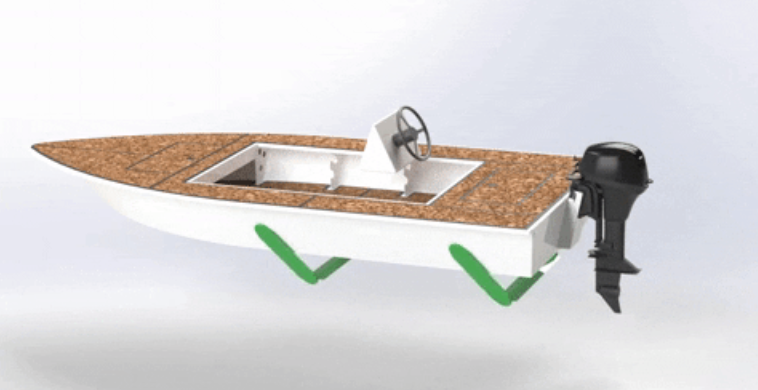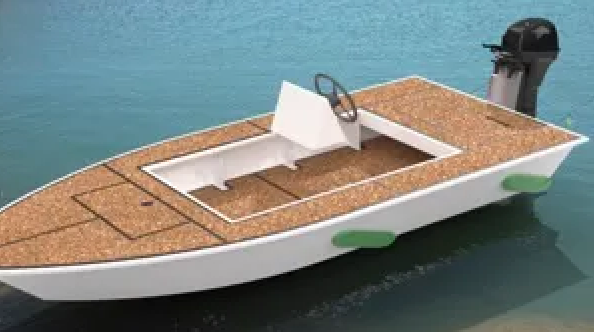Industry Veterans Create Electrically Powered Skiff

With a patent-pending retractable system that deploys at speed, the new electric hydrofoiling skiffs from Epoch Boats are the “fishing boats that fly.” They offer an average boater a foiling experience at a more affordable price.
Epoch Boats was founded in 2021 by Tom Ward and Diane Seltzer, who met while working at SureShade, the telescoping boat shade manufacturer. Ward was the director of engineering and Seltzer the director of marketing — she was named to Boating Industry magazine’s 25 Women Making Waves in 2020. Both are boaters who love being out on the water and connecting with nature. That’s what led them to electric boats.
Cleaner Water When I was Growing up
“I grew up sailing and rowing and I think anybody who spends their whole life on the water, you inherently have to be a conservationist, “ says Ward. “It’s all around you, you touch the water, you swim in it.”

“One of the things I’ve seen over my life is that the water was cleaner when I was growing up. Now, there are more boats, two strokes, boats smoking out on launching ramps, more oil slicks — and it started to weigh on me.”
In a previous job, Ward was responsible for maintaining four boats in his company’s test fleet. “Between carburetor rebuilds, new impellers, oil changes and all of it, it just hit me one day that electric has to be better,” he said. “So I went out and bought myself an electric boat. It’s a great little unit, 14’ aluminum with a 6-lb. (2.72 kg) thrust trolling motor. Perfect for fishing, puttering around on the lake, but it doesn’t have the speed to make your heart race.”
He continued, “I looked around at higher-performance electric boats, but they were simply too far out of my price range, and really, a lot of them aren’t made for what I want in a boat. I just want something to go out fishing, but also have a little zip available for getting there and back quickly, or for just the sheer fun of going fast.”
Demand for Small Electric Boat with Speed
This is where Seltzer’s marketing experience comes to the fore. “As Tom started sharing his thoughts with me, I knew from all the work and customer research I’ve done over the years that he is not the only one who would be interested in this kind of boat. We started talking about use cases, and the first that came to mind is someone with a skiff style boat — small, light, flat bottomed. They are very popular for fishing on the Texas coast and Florida panhandle, where there is a lot of shallow water.”

Ward and Seltzer realized there is a segment of the market that wants an electric boat with some speed, but it also has to fit into their recreation budget. “They could be looking for just a fun day boat, a dinghy or tender for a yacht or a fishing boat for any lake, not just shallow water situations,” said Seltzer. “We’re in Pennsylvania, where almost half of our waterways – 47% – are electric only.”
So they decided to take the plunge and start an electric boat company, calling it ‘Epoch’ because the word means “the beginning of a distinctive period in the history of something.”
Affordable Foils
Ward has a tremendous knowledge of the mechanics of boats — he sits on the Technical Board of the American Boat & Yacht Council (ABYC) — and knew that hydrofoiling would give a skiff the best option to combine speed with battery range.
Surface Piercing vs. Fully Submerged
When it comes to hydrofoiling electric boats, the Candela 8 is being lauded as the gold standard. Ward appreciates its technology and performance, but it’s a 27’ (8 m) performance boat designed for a different use than Epoch is looking at. Ward also knew that Candela style technology wouldn’t be practical for skiff he wanted to create.

There are basically two types of hydrofoil design: surface piercing and fully submerged. Candela uses fully submerged foils that provide a smooth ride, in part because the boat is raised well above the water and almost literally flies, with only a couple of foils slicing through the water and creating next-to-zero drag.
The challenge is that they do not self-adjust for stability as the boat moves through the water. Candela’s engineers overcame that with computer software that receives and reacts to thousands of bits of data and adjusts the foils hundreds of times a second.
As the name implies, surface-piercing break the surface, but a significant portion of the foil is always in contact with the water surface. This means that the boat can’t rise above the waves and the ride won’t be as smooth, but the advantage is that the contact with the water makes surface-piercing foils self-adjusting. They don’t need the technology and associated expense of the fully submerged design.

Aluminum Electric Hydrofoiling Skiff
With Ward’s and Seltzer’s connections in the marine industry, they got others excited about the possibilities of an electric skiff with surface piercing foils and work began on the prototype.
The boat will be made of aluminum, due in large part to the target audience. Skiff users in Texas and Florida often travel across oysters beds, and the razor sharp edges of oyster shells can ruin a fiberglass hull.
For Epoch electric hydrofoiling skiffs, the hulls are fitted with the foils that can be raised and lowered at amidships and near the stern. The electric outboard motor moves with the foils along a track on the transom to make sure the propulsion is always aligned with the foils to create and maintain lift. The controls are similar to a power tilt and trim system.

At low speeds and in shallow water, the Epoch looks and operates like any other small boat and has a draft of 4” (10 cm). When it’s time to take off, deploy the motor and the foils, lowering them to a draft of 15″ (38 cm) and the boat automatically elevates at speed to get up and “fly.”
Epoch says that steering feels the same as a planing boat. The surface-piercing foils work like a second hull operating below the primary bottom, but with a lower water resistance.
Close to a Similarly Sized Fossil Fuel Powered Boat
Foils can be a great solution for one of the dilemmas of small electric boats. The smaller the boat, the more critical the issue of battery weight becomes. Getting a 14’ to 18’ (4.27 m to 5.49 m) skiff to plane requires a certain amount of speed, so a battle of physics takes place. More speed requires a larger, heavier battery but a bigger battery needs more power to attain plaining speed that requires more battery.

The Epoch has Space for Casting and Bringing in Fish.
“People talk about the weight of batteries in boats,” says Ward. “But the reality is an ICE motor has a cast metal power head, a drive shaft, a gearbox…you put five gallons (18.93 L) of fuel in, and you’ve got about 100 lbs. (50 kg). An electric outboard might weigh 40 lbs. (18.14 kg), so even with 80 lbs. (36.29 kg) of battery, we end up with only about 10 or 20 lbs. (5-10 kg) of difference.”
Seltzer adds that most people don’t use all the fuel in their boat on a single outing. “When we look at the recreational boating industry, particularly in North America, about 70% of the customers have a use case that fits into that spot where they can transition to batteries. With the increased range at high speed provided by hydrofoiling, the Epoch is going to be close to a similar size fossil fuel powered boat.”
When it comes to cost, the Epoch Skiff starts at $35,000 with motor and battery included. The company is working with a couple of manufacturers for a range of boat/motor packages to fit 14’ (4.27 m), 16’ (4.88 m) and 18’ (5.49 m) models. On the smaller version, the jumping off point is a 7-12kW (10-15 hp equivalent) motor with a 5kWh battery.